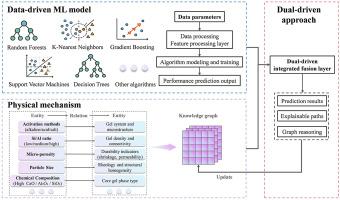地质聚合物性能预测的机器学习方法综述:将数据驱动模型与物理洞察力联系起来
IF 7.4
2区 工程技术
Q1 CONSTRUCTION & BUILDING TECHNOLOGY
引用次数: 0
摘要
建筑行业的碳排放在世界范围内变得越来越重要。地聚合物作为波特兰水泥的绿色和低碳替代品,为可持续建筑应用提供了巨大的潜力,因此吸引了广泛的研究兴趣。地聚合物的性能受到多种相互作用因素的影响,使得传统的试错方法成本高昂且效率低下。虽然机器学习(ML)已广泛应用于预测地聚合物性质,但纯粹的数据驱动模型仍然受到黑箱行为、弱泛化和依赖数据质量的限制。本文系统地研究了(i)数据驱动机器学习在地聚合物研究中的应用和主要算法,(ii)为物理驱动策略提供信息的潜在反应机制,以及(iii)将数据与物理相结合的新兴双驱动框架。双驱动方法代表了一种新的范式,它将预测能力与机械理解联系起来,同时提供准确性和可解释性。有证据表明,集成学习和深度神经网络在数据驱动预测中具有最好的稳定性和鲁棒性。结合物理洞察增强了可解释性和可靠性,而结合两种方法的混合策略进一步提高了系统的稳定性和准确性。与以往的综述主要集中在数据驱动模型上不同,本文强调了物理反应机制与ML的集成,并强调了知识图引导路径是有前途的方向。这种集成通过知识引导学习、实验验证和反馈校正实现闭环优化,最终支持地聚合物知识-数据协作平台的开发,推进可持续材料设计。本文章由计算机程序翻译,如有差异,请以英文原文为准。

A review of machine learning methods for geopolymer performance prediction: Linking data-driven models with physical insights
Carbon emissions from the construction industry are becoming increasingly significant worldwide. Geopolymers, as green and low-carbon alternatives to Portland cement, offer great potential for sustainable building applications and have therefore attracted broad research interest. The performance of geopolymers is affected by multiple interacting factors, making conventional trial-and-error approaches costly and inefficient. While machine learning (ML) has been widely applied to predict geopolymer properties, purely data-driven models remain limited by black-box behavior, weak generalization, and dependence on data quality. This review systematically examines (i) the applications and dominant algorithms of data-driven ML in geopolymer research, (ii) the underlying reaction mechanisms that inform physically driven strategies, and (iii) the emerging dual-driven frameworks that integrate data with physics. The dual-driven approach represents a novel paradigm that bridges predictive power with mechanistic understanding, offering both accuracy and interpretability. Evidence shows that ensemble learning and deep neural networks achieve the best stability and robustness in data-driven prediction. Incorporating physical insights enhances interpretability and reliability, while hybrid strategies combining both approaches further improve system stability and accuracy. Unlike previous reviews centered mainly on data-driven models, this paper emphasizes the integration of physical reaction mechanisms with ML and highlights knowledge graph–guided pathways as promising directions. Such integration enables closed-loop optimization through knowledge-guided learning, experimental validation, and feedback correction, ultimately supporting the development of a knowledge–data collaboration platform for geopolymers and advancing sustainable material design.
求助全文
通过发布文献求助,成功后即可免费获取论文全文。
去求助
来源期刊

Journal of building engineering
Engineering-Civil and Structural Engineering
CiteScore
10.00
自引率
12.50%
发文量
1901
审稿时长
35 days
期刊介绍:
The Journal of Building Engineering is an interdisciplinary journal that covers all aspects of science and technology concerned with the whole life cycle of the built environment; from the design phase through to construction, operation, performance, maintenance and its deterioration.
 求助内容:
求助内容: 应助结果提醒方式:
应助结果提醒方式:


